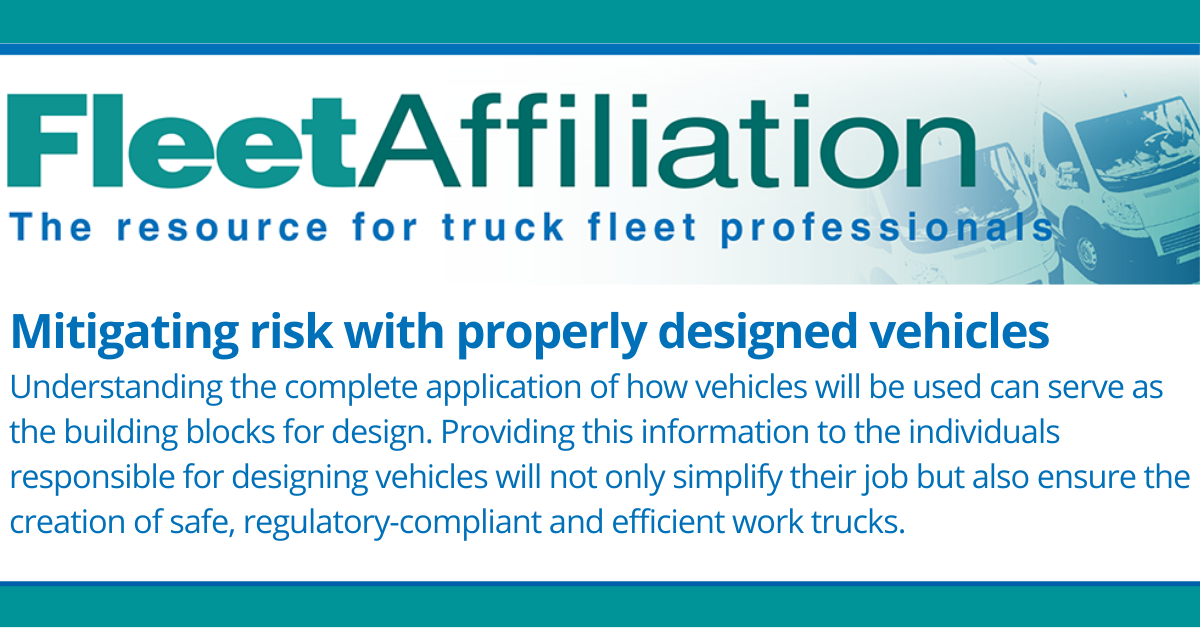Mitigating risk with properly designed vehicles

Published in March 2024 Fleet Affiliation.
Understanding your fleet’s risk exposure and what you can do as a fleet manager or specification writer can help reduce costs and minimize liability for your organization. At the top of the list, most fleet managers are extremely diligent about maintenance, safety inspections, employing properly licensed operators and maintaining thorough records. These are crucial tasks, but there may be misconceptions about where liability lies in the event of an incident. Risk management and mitigation begin with providing operators with safe vehicles. Regardless of how meticulously maintenance and repairs are carried out, having a properly designed vehicle for the task is of extreme importance. If deploying vehicles that are not appropriately designed for their intended tasks, an organization may unknowingly be increasing its risk exposure.
Understanding upfitter limitations
As a fleet, it’s important to work closely with your upfitters, dealers and fleet management companies (FMCs). Fleet managers may have the misconception that relying on these third-party entities to design their vehicles reduces their organization's risk (e.g., if someone else designs the vehicle, the responsibility and liability fall on the designer). However, this is not completely true. Although parties have a responsibility to design trucks that meet safety requirements and fulfill their intended application, there's a catch: they are likely basing their designs on information given to them. It’s critical to provide them with the most accurate details on the intended application, how the truck will be used, operating environments and loading requirements. Providing inaccurate or incomplete information will likely result in shifting liability and risk back to your organization.
Safety begins with vehicle design
Regardless of the spec’ writer — whether in-house, an FMC or by pre-engineered specifications from a dealer, upfitter or OEM — there are four major areas that should be addressed to reduce and control risk:
- Chassis selection: Selecting a proper chassis is the first step. The vehicle cannot be overloaded for the intended purpose. This includes considering axles, frames, brakes, tires and springs. It's essential to keep in mind that the completed vehicle will have to comply with all Federal Motor Vehicle Safety Standards (FMVSS) and/or Canada Motor Vehicle Safety Standards (CMVSS).
- Vehicle upfitting and componentry: Similar to the chassis, it’s critical to design the vehicle and upfitted components properly to meet the intended application.
- Safety: Ensuring quick access to fire extinguishers, and having emergency shut-offs for systems such as fuel, electric and hydraulic applications, along with proper labeling, is crucial for safety.
- Cargo: Properly securing cargo is important. Operators can be notorious for becoming creative with cargo management. Understanding what needs to be transported and providing easy ways to secure cargo may help lower your organization's risk.
Design based on application
Understanding the complete application of how vehicles will be used can serve as the building blocks for design. Providing this information to the individuals responsible for designing vehicles will not only simplify their job but also ensure the creation of safe, regulatory-compliant and efficient work trucks. This can help reduce your organization's risk exposure and facilitate the development of more effective vehicles, potentially lowering overall operating expenses.
